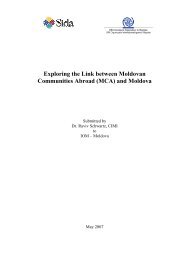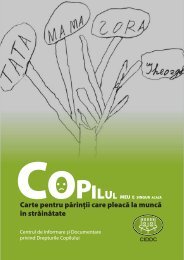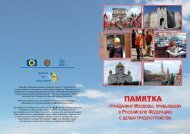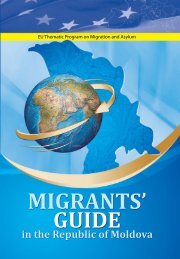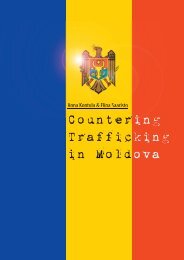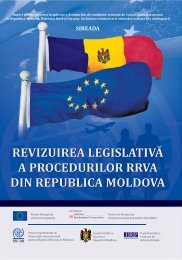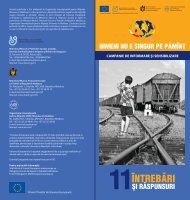Trafficking in Human Beings in Southeastern Europe - Iom
Trafficking in Human Beings in Southeastern Europe - Iom
Trafficking in Human Beings in Southeastern Europe - Iom
- No tags were found...
You also want an ePaper? Increase the reach of your titles
YUMPU automatically turns print PDFs into web optimized ePapers that Google loves.
<strong>Traffick<strong>in</strong>g</strong> <strong>in</strong> <strong>Human</strong> Be<strong>in</strong>gs<strong>in</strong> <strong>Southeastern</strong> <strong>Europe</strong>Not many women and girls receive really long-term support. Accord<strong>in</strong>g toIOM, re<strong>in</strong>tegration assistance should “address the root causes of traffick<strong>in</strong>gand avoid potential re-traffick<strong>in</strong>g of the victims after return. Re<strong>in</strong>tegration elementsto be <strong>in</strong>cluded are, <strong>in</strong>ter alia, medical and psychological assistance,security protection, vocational tra<strong>in</strong><strong>in</strong>g, job referral, subsidised employment,self-employment and micro credits.” 165Victim Referraland AssistanceSystem andGaps There<strong>in</strong>In reality, accord<strong>in</strong>g to NGO and IOM data, these components are rarely delivered.The rout<strong>in</strong>e procedure is to send women back to the place from whichthey were trafficked with a list of NGOs operat<strong>in</strong>g nearby. It appears that contactwith IOM is usually cont<strong>in</strong>ued only because the women have to stay <strong>in</strong>touch to collect the second and third <strong>in</strong>stalments of their social supportmoney. Additionally, local NGOs give the reasons why returned women do notcont<strong>in</strong>ue to seek support as a lack of resources, of local capacity and of longtermservice provisions.As many NGOs po<strong>in</strong>t out repeatedly, work<strong>in</strong>g with trafficked women is a verydifficult and long-term process. It requires well-tra<strong>in</strong>ed and committed staff,a good understand<strong>in</strong>g of the issue and a well-developed work methodologyand <strong>in</strong>dividual approach to each case. Some of the women, who are suffer<strong>in</strong>gfrom post-traumatic stress disorder need long term (two to three years) <strong>in</strong>dividualtherapy. The majority need far reach<strong>in</strong>g economic and social support:vocational tra<strong>in</strong><strong>in</strong>g; jobs; hous<strong>in</strong>g; micro-credits. At this moment this k<strong>in</strong>d ofre<strong>in</strong>tegration assistance is available to almost no one. Of the 35 percent oftrafficked women and girls repatriated to their home country, it would appearthat only one <strong>in</strong> five, or seven percent, received any k<strong>in</strong>d of long-term help orsupport.Another issue is the security of the return<strong>in</strong>g women. While their security is apriority <strong>in</strong> the country of dest<strong>in</strong>ation and dur<strong>in</strong>g the journey home, there is notmuch consideration for their safety after return. There are no security measuresfor the women once they have returned. In situations where women stillowe money to the traffickers, or where they have testified aga<strong>in</strong>st them, theyor their families can be <strong>in</strong> danger. Women placed <strong>in</strong> the same environmentfrom which they were trafficked, without any protection, are easy targets forre-traffick<strong>in</strong>g and, if they had decided to testify, for revenge.It has to be said that the system of return and re<strong>in</strong>tegration assistance doesnot yet work well, when less than seven percent of trafficked persons receivereal assistance and support. It requires the provision of support, services andsecurity to ensure that women and girls are not caught up <strong>in</strong> a cycle ofrepeated traffick<strong>in</strong>g. The NGOs’ capacity to assist victims is very limited –shelters are small and ma<strong>in</strong>ly used for the victims of domestic violence. Often,there are no tra<strong>in</strong>ed psychologists or social workers that could help thewomen. The special needs of girls under 18 are not addressed at all. Feworganisations that could help have resources for start<strong>in</strong>g programmes for traffickedpersons. No one is offer<strong>in</strong>g long term re<strong>in</strong>tegration programmes – professionalskills tra<strong>in</strong><strong>in</strong>g, educational opportunities, or loans. Except for verybasic temporary accommodation for the most desperate women, there is noalternative to return<strong>in</strong>g to the traffickers or go<strong>in</strong>g back home, usually to thesituation which had created the conditions for the woman to be trafficked <strong>in</strong>the first place.164.Information from “Save the Children Moldova”, <strong>in</strong>terview with Mariana Petersel, 20 July2001.165.“<strong>Traffick<strong>in</strong>g</strong> <strong>in</strong> Persons: Update and Perspectives”, IOM, MC/INF/245, 22 November 2000,p.3.145



